The woodland on the property is mixed evergreen forest, composed of a variety of native California tree species, including Coast Redwood (Sequoia sempervirens), California Bay Laurel (Umbellularia californica), Pacific Madrone (Arbutus menziesii), Douglas Fir (Pseudotsuga menziesii), and various species of oak (Quercus sp.).
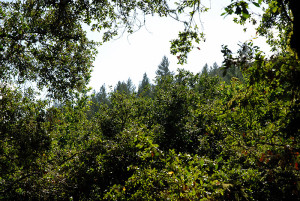
Our evergreen woodland areas are made up of a number of native tree species, including oaks (click any image below to enlarge)
Of these trees, the most confounding, and confusing, to identify are some of our oaks.
The challenge with identifying which oak species inhabit our woodlands is that oaks in this region are highly adaptive to the environment they are growing in, and some species, within a particular oak lineage, may hybridize with each other. This can result in significant variability in growth habit, and leaf morphology, making species identification difficult.
It isn’t difficult just for the gardener, as there is significant discussion among ecologists, and botanists, as to the identity of some of California’s oak species. Some of the oaks growing here are easily identified, such as our Canyon Live Oaks (Quercus chrysolepis), but the identity of the other Live Oak species is proving to be more challenging.
We had presumed until now, not looking very closely at our oaks, that Coast Live Oaks (Quercus agrifolia) likely predominated here. However, the Interior Live Oak (Quercus wizlizeni), and Coast Live Oak look very similar at first glance. Both belong to the Red Oak subgenus, Erythrobalanus, and their leaf margins typically have bristle-like teeth, although the margins may be smooth. However, an important distinguishing feature between the two is that the leaves of the Interior Live Oak are flat, not convex like their Coast Live Oak cousins.
Underneath the leaves, the Coast Live Oak also has fine tufts of hairs where the lateral veins meet the central midline vein, whereas the ventral leaf surface of the Interior Live Oak is glabrous (hairless).
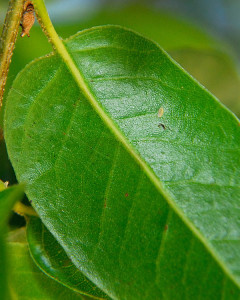
The ventral surface of this leaf lacks the axillary hairs characteristic of Coast Live Oaks (Q. agrifolia)
The leaves from this particular tree are clearly hairless, ruling out a Coast Live Oak, so that should narrow the species to Interior Live Oak…or does it?
To complicate matters further there has been some significant discussion in the literature in recent years regarding a mainland form of the Santa Cruz Island Oak (Quercus parvula). Quercus parvula has a limited range, found in coastal Santa Barbara county, and of course on Santa Cruz Island. The mainland relative of the Santa Cruz Island Oak is known as the Shreve Oak (Quercus parvula var. shrevei), and has a much wider distribution along California’s coast.
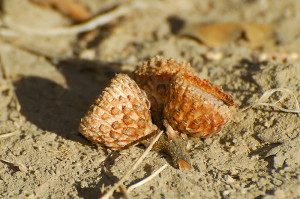
The acorn cups of Interior, Shreve, and Coast live oaks have overlapping scales, resembling roof shingles
This Shreve Oak subspecies reportedly grows from San Francisco, south through the Central Coast ranges, and is especially concentrated in the Santa Cruz, and Santa Lucia mountain ranges. However, the key to California Oaks I have in front of me suggests that the Shreve Oak should have convex leaves, more similar to the Coast Live Oak, not flat leaves like the Interior Live Oak [1].
As a result of that key, I thought I could rule out the Shreve Oak here, but in 2002 Dodd et al. stated that “central coast populations [of Interior Live Oak] at low elevations, typically occupying redwood forest should be treated as Shreve oak“[2]. Taxonomists were advocating the split of the Shreve Oak from populations of oaks that were once believed to be Interior Live Oaks, while admitting that differentiation between the two species based on morphological features alone may be virtually impossible.
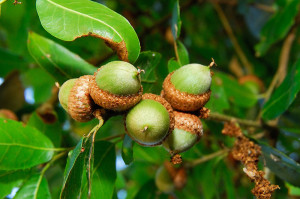
For many species, the characteristics of the acorns and their cups may be diagnostic, but not always
A more recently published text describes Shreve Oaks as single trunked trees, with leaves similar to the Interior Live Oak, but generally longer, up to 5 inches in length[3]. Here these oaks are indeed single trunked, generally taller than they are wide, but the leaf sizes tend to be smaller, in the 2-3 inch range, certainly nowhere near 5 inches in length.
As Live Oak leaf morphology is variable though, depending on local growing conditions, a species identification based on leaf length alone would be inadequate.
Our attempts to conclusively identify this oak species has caused more than a few headaches, so for now it seems that we’ll simply have to accept the absolute identity of these Interior Live Oak/Shreve Oaks on the property, without a more expert analysis, will remain a mystery.
It really seems quite remarkable that something as large as a 50 foot oak tree could be as difficult to identify as some of the species of fungi we find growing here in the winter.
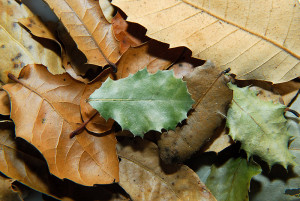
Regardless of species, all of our oaks provide important habitat for a range of plant and animal species
Whether these oaks are officially Interior Live Oaks, or Shreve Oaks, is really of little consequence to the wildlife species that depend on our oak woodland habitat. Arboreal Salamanders use the cavities in our oaks to lay their eggs. The Coast Range Fence Lizards, Skilton Skinks, Alligator Lizards, and Ringneck snakes forage, protected, among the oak leaf litter. Pocket Gophers, Western Gray Squirrels, and Acorn Woodpeckers rely heavily on the acorns produced in the fall as stores for winter.
With the exception of the Coast Live Oak, acorns from oaks in the Red oak subgenus take two full years to mature. As a result, it’s not uncommon to see maturing acorns, and tiny developing acorns on the same branch of an Interior Live Oak, or Shreve Oak.

It's common to find acorns in various stages of development on Live Oaks, except for the Coast Live Oak whose acorns develop within a single season
Walking around the property the past few weeks there is no question where the acorn-laden oaks are, as our resident Acorn Woodpeckers (Melanerpes formicivorus) this fall are relishing the tremendous abundance of acorns being produced this year.
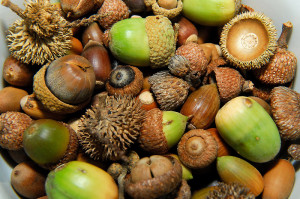
The abundance of acorns this year will be beneficial to the wildlife species that depend on them for food
Each morning we can hear the woodpeckers calling to each other as they busily forage from tree to tree, collecting the acorns to store in their granary trees.
These woodpeckers will rely on these acorn reserves during inclement winter weather, and during the spring nesting season.
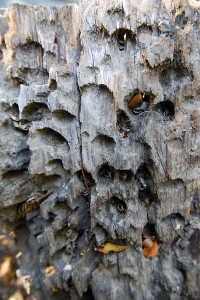
Remnant of an old granary tree here at Curbstone Valley, a communal pantry, used by Acorn Woodpeckers. Up to 50,000 acorns may be stored in any one granary.
These oaks also support other life, whether literally, as a vining support for our native honeysuckle, or by providing the perfect soil conditions for our golden chanterelles.
Our mystery oaks however, aren’t the only oaks in our woodlands. We also have Scrub Oaks, and Canyon Live Oaks growing here, along with some false oak species, including the Tanbark Oak, and of course, our dreaded poison oak, which is just starting to turn a vivid shade of red for the fall.
—————-
[1] Pavlik, Bruce M., Muick, Pamela C., Johnson, Sharon G., and Popper, Marjorie. 1991. Oaks of California. Cachuma Press.
[2] Dodd, Richard S.; Kashani, Nasser; Afzal-Rafii, Zara 2002. Population diversity and evidence of introgression among the black oaks of California. In: Standiford, Richard B., et al, tech. editor. Proceedings of the Fifth Symposium on Oak Woodlands: Oaks in California’s Challenging Landscape. Gen. Tech. Rep. PSW-GTR-184, Albany, CA: Pacific Southwest Research Station, Forest Service, U.S. Department of Agriculture: 775-785.
[3] Costello, L.R., Hagen, B.W., and Jones, K.S. 2011. Oaks in the Urban Landscape: Selection, Care, and Preservation. University of California Agriculture and Natural Resources.

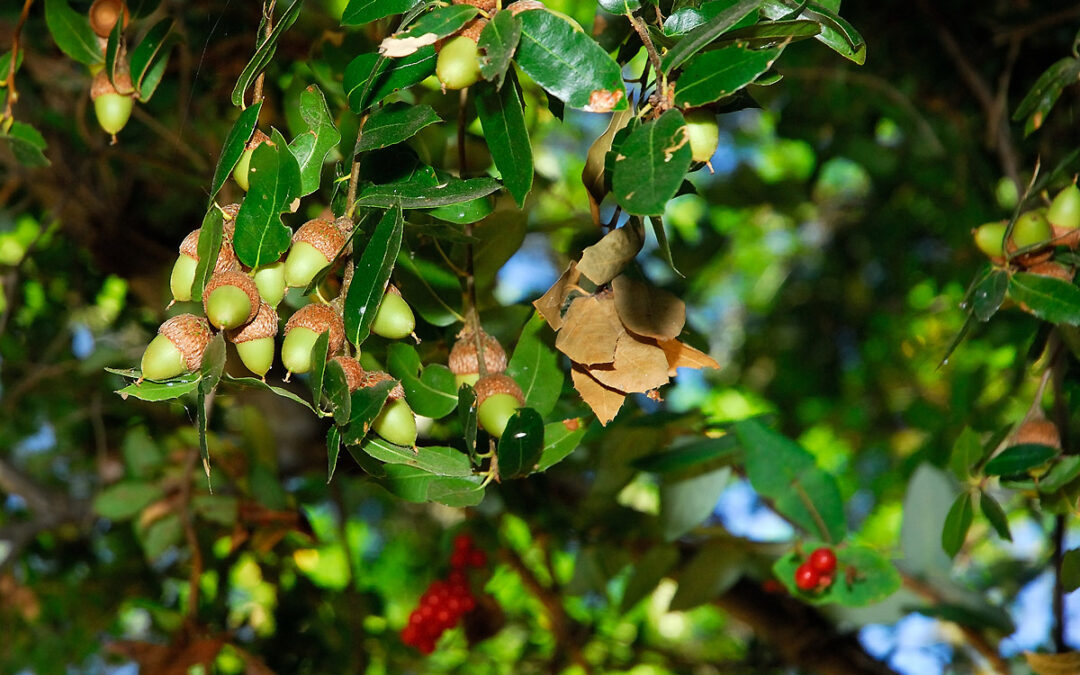
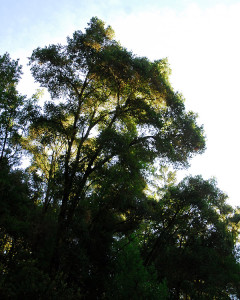


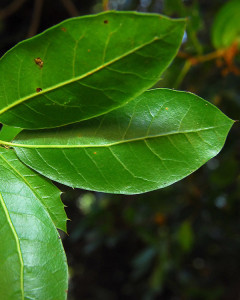

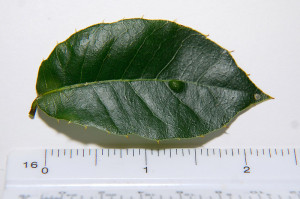
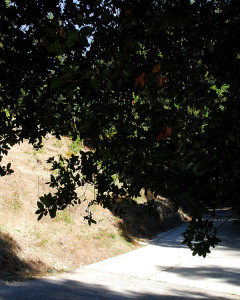

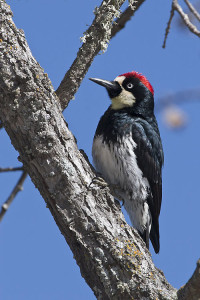
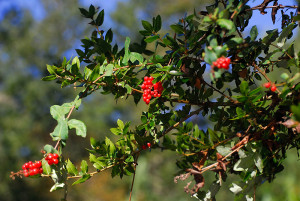







Your unidentified Oak just may be a Holly Oak.
Leave somewhat like the Live Oak, but with neadles on the leaves.
My ref is fom the Simon & Schuster’s Guide to Trees Picture #153.
I admit the leaves of our coastal Live Oak species are similar in appearance to the Holly Oak (Quercus ilex). However, the Holly Oak is not native to California, and with the significant age of some of these trees, I’d think it unlikely for them to be a foreign species. The underside of the leaves of the Holly Oak also have quite dense short hairs, unlike either our Interior/Shreve, or Coast Live Oak (which only has scant axillary hairs). A very good thought though! 🙂
I’ve heard of woodpeckers storing acorns in trees before. That must be an amazing sight to see and how wonderful that you have such a tree on your property. Oak identification reminds me of asters. The differences are so small it’s a wonder to me that anyone can tell them apart.
This piece of the old granary is an old log that the previous owners left us. I’m assuming the rest of that tree fell, or was cut down, and used for firewood at some point, but I’m glad they left this piece. I hear the woodpeckers drilling a lot around here, so I’m sure there’s a standing granary somewhere, I just haven’t found it yet 😉
Then we look forward to seeing your standing granary, when you find it. How fascinating!
Clare,
Looks pretty interesting, you know a 50 year old tree could be an introduced tree, acorns can travel. No offense to William, but Simon & Schuster’s Guides I have seen are never much good.
Actually, some of these trees are closer to a 100 years old, since this land was clearcut when the redwoods were logged, but yes, it is always possible for exotic species to be here, even from some time ago. In this case, this is isn’t the only tree. There are a number of them throughout the wood areas in these part of the mountains. I’m pretty certain this is a native live oak, I just wish the taxonomists would stop confusing us by resorting the species! 😛
The abundant acorns are great for the wildlife, but often are a result of the tree exhibiting stressed conditions the previous year. Here, our maples produced excessive seed in the helicopters and that was from our drought the previous year. Next year may be similar since we had high heat and little rain during the summer months. And I hate those helicopters.
That’s interesting. It’s true that I’ve seen some very stressed plants in the past that will produce a seed at all cost before ultimately meeting its demise. In the case of these oaks, I expected that our previous two years with abundant rainfall during winter and spring had enabled these trees to finally produce a significant crop of acorns this year. The first two years here were tremendous drought, but winter through spring 2009-10 saw the return of more normal rainfall. This spring also was quite wet, and we’ve never seen more acorns here. I wonder if oaks respond to environmental stress by shutting down, or ramping up acorn production?
I think it’s an interior live oak. I have two near my house and they look very similar to the one in these pictures. 🙂
but yeah, identifying between coast live and interior can sometimes be tricky.
Well, that’s just it, I agree it is not a Coast Live Oak, but because of where it’s growing is it likely to be the Shreve Oak subspecies that was split from the Interior Live Oaks recently? The Coast Live Oak, under close examination, is easier to differentiate, but the Interior and Shreve, even the botanists struggle to sort out! 😛
Great post, interesting! I read somewhere recently that Acorns can be harvested, ground and used as a chicken food. In Ireland, maybe in America too Oaks are host to over 600 species of wildlife.
Some people in the US do feed acorns to their chickens. I think some oak species have higher tannin contents in their acorns tough, so not all acorns are palatable, or necessarily good to feed in excess. Our girls don’t seem too interested in them when they’re foraging about…but they’re very well fed, and somewhat lazy 😛
I’ve enjoyed this post and the back and forth of your commentors as to the ID of the tree… but I must admit, your oaks are light years away from what our oaks look like. This is most amazing to me. I’ve learned something new!
I grew up with English Oaks, deciduous trees, with the classic lobed oak leaves. When I first moved to California, and people told me these were oak trees, I almost didn’t believe them! These evergreen oaks do look a lot different, but I find it quite remarkable how these trees have adapted to drought conditions with their thick leathery leaves!
What a fascinating post. The diversity of the trees you have is wonderful. I have always wanted to be close to woods or own some to learn about the trees. Ours are pretty simple, but you have piqued my interest to learn more about even the few we have , but others that may be close by….
We do have a wonderful diversity of trees here. This is the first property we’ve owned where we can’t count all the trees here! I feel quite blessed to be surrounded by natural woodland, and all of the plants and animals contained within.
I would love to do a project on the diversity of trees in my surrounding area and I loved that little collection of acorns. We just have English oak trees here Quercus robur and their leaves look so different to your oaks – I suppose its a bit like the difference between a british robin wildbird and a US one.
I remember a HUGE and very imposing English Oak at the foot of our neighbor’s garden in England. My bedroom window used to face that Oak as a child, and it’s image is permanently etched in my memory. I so loved that tree, watching the squirrels and birds that lived in it. I thought all oak trees looked like that, but here in the US I’m impressed with the diversity of oak species. Some look more similar to the English Oaks in stature, and leaf, and others, like these evergreen Live Oaks, don’t look like an oak at all. I agree with the robins too, side by side they’re nothing alike (I still favor the little English robins). 🙂
I had forgotten that there were evergreen oaks. I don’t think any grow in PA but I could be wrong. I would love to have one. In Bringing Nature Home, Doug Tallamy says that oaks are the most important plant for supporting native insects.
It wouldn’t surprise me at all, as each spring, especially when the catkins bloom, these trees are humming with insect life. Then if you examine the leaves closely it’s not difficult to find insect damage to the leaves, weevil holes in the acorns, and galls from wasps on the leaves and branches. It’s as if each oak is it’s own ecosystem!
Interesting! I was unaware of evergreen oaks and needless to say am of no help to you. Another commenter was correct in saying that oaks provide food and shelter to over 600 species of insects and animals. You have an amazing and diversified ecosystem in your backyard.
The more I’ve come to know some of the wild creatures that live here, like our slender and arboreal salamanders, and some of the bird and mammal species, it’s clear to me that without oaks on the property, the wildlife we see would likely be different, at least in number if not in species. It’s really remarkable how many species depend on their presence. Rather makes me want to plant MORE oaks!
Sorry you couldn’t figure out your tree’s identity. That must be a bit frustrating. Since people know I garden, I get asked a lot of times what certain trees identities are, and I know (some) flowers, but trees are a complete mystery to me. I do, however, know poison oak! 😉
It is a little frustrating, but mostly because I hate to admit defeat 😛 You’d think with the oak keys I’ve been reading through all week I’d have figured it out, but those oaks are wily, and quite content to retain their anonymity!
Clare, what a nice post, admirable and comprehensive! I love to learn to ID trees and wish to know more about the ones we have closeby and especially in the high country. I was delighted to find that we have an oak hybrid, the Oracle Oak on our place.
I appreciate know the differences in the leaves and the trunks. It would be odd to see one of our Interior Live Oaks with a single trunk, so often they are double and triple trunked. And they are most often wider then tall.
It would be nice to have a huge variety of trees, but we have about 6 or 7 only on the place. I hink that’s common in my area.
I was reading about the Oracle oaks yesterday, and I just now dropped by your Oracle oak post from last year (somehow I missed it when you published it). How fun that you actually have some of these more elusive hybrids.
These trees are interesting in their stature, being so much taller than they are wide, which does cause me to lean more toward the Shreve Oak for this species. The leaves are smaller than described for Shreve, but our soils are very sandy, don’t retain nutrients well, and prone to be desert dry in the summer months, all of which I’m sure stresses the trees, and their small leaves may simply be their adaptation to drought. Our Canyon Oaks seem prone to multi-trunks, each of which can attain a substantial girth, but these are all single trunked specimens (except where two have grown together giving the illusion of paired trunks).
Very interesting article and I love that you took the time to get really crisp photos to add to it as well. Id have to say my favorite oak is the live oak tree.
This is a very informative post, especially for us in the tropics who are not familiar with oaks, we just read about them. I’ve seen a real oak tree only once yet, and i really looked at it for a long time despite the so many trees around it. Then i learned also that they don’t shed leaves even if they are already dry, it even has a technical term which i not forgot, haha!